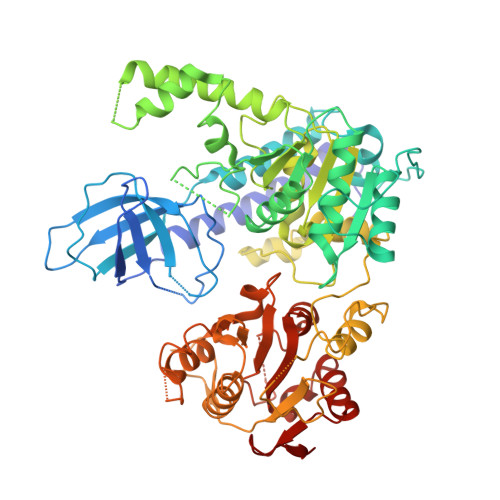A conserved structural element in the RNA helicase UPF1 regulates its catalytic activity in an isoform-specific manner.
Gowravaram, M., Bonneau, F., Kanaan, J., Maciej, V.D., Fiorini, F., Raj, S., Croquette, V., Le Hir, H., Chakrabarti, S.(2018) Nucleic Acids Res 46: 2648-2659
- PubMed: 29378013
- DOI: https://doi.org/10.1093/nar/gky040
- Primary Citation of Related Structures:
6EJ5 - PubMed Abstract:
The RNA helicase UPF1 is a key component of the nonsense mediated mRNA decay (NMD) pathway. Previous X-ray crystal structures of UPF1 elucidated the molecular mechanisms of its catalytic activity and regulation. In this study, we examine features of the UPF1 core and identify a structural element that adopts different conformations in the various nucleotide- and RNA-bound states of UPF1. We demonstrate, using biochemical and single molecule assays, that this structural element modulates UPF1 catalytic activity and thereby refer to it as the regulatory loop. Interestingly, there are two alternatively spliced isoforms of UPF1 in mammals which differ only in the lengths of their regulatory loops. The loop in isoform 1 (UPF11) is 11 residues longer than that of isoform 2. We find that this small insertion in UPF11 leads to a two-fold increase in its translocation and ATPase activities. To determine the mechanistic basis of this differential catalytic activity, we have determined the X-ray crystal structure of the helicase core of UPF11 in its apo-state. Our results point toward a novel mechanism of regulation of RNA helicases, wherein alternative splicing leads to subtle structural rearrangements within the protein that are critical to modulate enzyme movements and catalytic activity.
- Institute of Chemistry and Biochemistry, Freie Universität Berlin, Takustr. 6, D-14195 Berlin, Germany.
Organizational Affiliation:
















